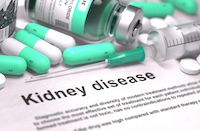Article
Advancing American Kidney Health
Author(s):
Released the day following President Trump's address, results of a study from investigators at UCSF highlight issues in care of patients with chronic kidney disease.

On the heels of President Trump’s address on the need to improve care for patients with kidney disease, results from a recent study reveal that chronic kidney disease (CKD) patients are facing continual, significant gaps in care. 


A study from investigators at the University of California San Francisco (UCSF) found that patients with CKD had a high prevalence of uncontrolled hypertension and diabetes and a low use of statins that did not improve over the course of the study. 


"Even when physicians are aware of a patient's CKD diagnosis, there are substantial gaps in quality of care," said lead author Sri Lekha Tummalapalli, MD, MBA, a nephrology fellow at UCSF. "The lack of improvement over a decade highlights a more urgent need for CKD-specific quality measures and the implementation of quality-improvement interventions."


With more than 30 million Americans suffering from kidney disease and the goal of improving care in mind, investigators conducted the cross-sectional study to examine trends in the quality of CKD care. Using data from the National Ambulatory Medical Care survey from 2006 through 2014, investigators identified 7099 unweighted visits for patients with CKD — representing 186,961,565 weight visits. 


Investigators divided data into 3 different categories, based on time period, for comparison. The time periods were 2006 to 2008, 2009 to 2011 and 2012 to 2014. Investigators noted that 2006 was chosen because it was before the passage of the Medicare Improvements for Patients and Providers Act and the Affordable Care Act.
Investigators had data on blood pressure (BP) measurement, uncontrolled BP among patients with hypertension, uncontrolled hemoglobin A1c (HbA1c) among patients with diabetes, angiotensin-converting enzyme inhibitor (ACEi) or angiotensin receptor blocker (ARB) use among patients with hypertension, statin use if age was 50 years old or greater, and nonsteroidal anti-inflammatory drug use.
In weighted analysis, investigators found that 2.7% of visits were for patients with diagnosed CKD. Patients with visits from CKD during the study period had an average age of 69 years, 53% of them were female, and 69% were non-Hispanic white.
Investigators noted that there was no difference in the prevalence of uncontrolled hypertension, defined as greater than 130/80 mm Hg, over the course of the study period (46% in 2006 to 2008 versus 48% in 2012 to2014; P =.50). Investigators also noted that there was a high prevalence (40%) of uncontrolled diabetes, which was defined as HbA1c greater than 7%, in 2012 to 2014.
Additionally, the prevalence of ACEi and ARB use decreased from 45% in the 2006 to 2008 time period to 36% in the 2012 to 2014 time period, but investigators wrote these results were not statistically significant. Statin use among patients with CKD who were 50 or older was low and little change was seen between the 2006 to 2008 period (29%) and the 2012 to 2014 period (31%).
Tummalaplalli relates the results of the study back to the idea that organizations, from hospitals to insurance companies, should be working collaboratively to create effective and consistent care for patients with CKD. In an interview with MD Magazine®, Tummalapalli lauded the admin statement on kidney disease — calling July 10, 2019 a historic day for all those with kidney disease. 


“The first goal of the Executive Order on Advancing Kidney Health in America is to reduce the risk of kidney failure,” Tummalapalli explained “Our study highlights the quality of care gaps in these areas, and the lack of improvement over time calls for a more urgent need for healthcare delivery interventions."
"If we want to achieve the bold vision the administration has set forth, we need to invest in implementation strategies that deliver care more reliably and effectively for people with chronic kidney disease.” Tummalapalli continued.
This study, titled “Trends in Quality of Care for Patients with CKD in the United States,” is published in the Clinical Journal of the American Society of Nephrology. 






